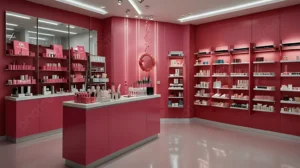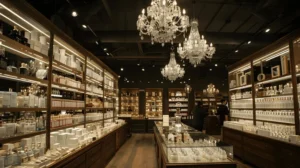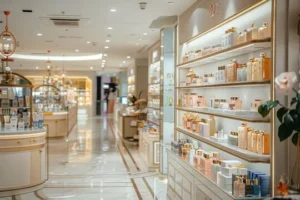Why do some perfume boutiques invest heavily in their interior designs? The answer lies in the Sales psychology (or the psychology of sales). The interior decor serves as the tangible representation of your brand’s promises. To sell your unique fragrances at competitive prices and achieve high profitability.
Today’s article on Jasmine will walk you through the most crucial ideas for Fragrance Store Interior Design that captivate customers and maximize your revenue, alongside the fundamental design principles, steps, and overall costs. Let’s dive in.
Importance of Perfume Boutique Interior Design in Business
When dealing with fragrances, you are essentially selling a sensory product. The interior design is the first element that captures the customer’s attention and determines their initial impression of your brand. Hence, the importance of design revolves around three main pillars:
1. Building the Initial Impression
- Customers subconsciously link the luxuriousness of the perfume shop’s decor with the quality of the products displayed, often even before testing the scent. (Applying the concept of Perceived Value).
- A sophisticated design reflects your brand’s professionalism and enhances the perceived value of the exclusive fragrances you sell.
2. Enhancing Product Focus
- Targeted lighting and the method of displaying the perfume bottles on shelves (the merchandising strategy) highlight the packaging details and bottle design.
- Effective spatial organization guides the customer directly to the fragrance categories they are looking for, which reduces search time and increases the likelihood of a purchase (Conversion Optimization).
3. Creating a Purchase-Inducive Environment
- Subdued colors and premium materials like dark wood or marble establish an atmosphere of tranquility and comfort, which is crucial for the process of testing scents (Scent Testing Environment).
- Providing comfortable, uncluttered spaces for fragrance testing (Sampling Stations) prolongs the customer’s stay inside the boutique, which naturally leads to an increase in your sales.

The Relationship between Interior Design and Visual Identity of the Brand
It can be said that decor and visual identity are two sides of the same coin, and harmony between them reinforces your brand’s message and strengthens customer affiliation.
So, how is this relationship manifested?
1. Colors and Materials
- The colors used in your logo and packaging must be integrated to support the visual recognition of the brand (Brand Recognition). If your brand emphasizes classical luxury, opt for dark, brass-toned elements and heavy, rich woods for the perfume shelving.
- Conversely, a modern, dynamic character requires the use of bright colors, sharp lighting, and sleek glass materials in the store’s detailing.
2. The Fragrance Message and Values
- It is essential that your store’s interior design embodies the message of the fragrances you offer. Exclusive perfumes featuring rare ingredients require independent display areas and directional lighting to highlight their value.
- A design focused on sustainability, on the other hand, necessitates natural or recycled materials. The visual embodiment of these values lends credibility to the customer of the product’s essence and quality.
3. The Touch Points
- Every point of contact (Touch Point) within the store must be designed to reflect your identity, from the entrance all the way to the final checkout counter.
- You should design the scent testing area (or sampling station) in a way that focuses attention on the product, utilizing materials that accentuate the beauty of your perfume bottles.
- The consistency (or visual coherence) among these elements elevates your perceived professionalism in the customer’s mind.
Fundamentals of Fragrance Boutique Interior Design
Design in this context demands precision in utilizing all five senses, while prioritizing lighting, display strategy, and customer flow. Let us clarify these fundamentals for you:
1. Ambient and Accent Lighting
- Lighting is a crucially important functional and aesthetic element in perfume store decor.
- Adopt warm, soft ambient lighting (General Lighting) to create an atmosphere of sophistication and comfort within the store.
- Concurrently, focus powerful task lighting (Spotlights) on the perfume shelves. This highlights the details of the packaging design, making the bottles more visually appealing to customers.
2. Shelving and Display Fixtures
- Design the perfume shelving with a focus on both practicality and elegance, integrating materials like glass, dark woods, or marble to reflect the required luxurious aesthetic of your boutique.
- Dedicate spaced-out and independent display units for your exclusive products and highly concentrated perfumes. These units should be placed at the customer’s eye level to facilitate easy access and testing of the products.
3. The Fragrance Sampling Station
- This is the most critical zone in any perfume shop, requiring a non-absorbent surface such as glass or marble to ensure the purity of the testing and prevent the blending of fragrances.
- It is essential to equip this area with the necessary supplies to reset the customer’s sense of smell, such as water or coffee beans.
- A well-designed testing area enhances the shopper’s ability to concentrate and spend sufficient time to make their final fragrance selection.
4. Traffic Flow
- The customer’s movement within the store should be natural and seamless, allowing them to navigate the perfume aisles without disruption.
- Allocate ample space in front of the main displays. This layout guides the visitor to browse all products calmly and reflectively.
- A flexible traffic flow plan (or Circulation Design) prolongs the customer’s time spent in your store and optimizes their purchasing decisions.
Jasmine can assist you with these fundamentals and more, in addition to supplying you with the fragrances that complement your store’s design. Our dedicated team is always available to answer your inquiries; simply contact us via WhatsApp.

Steps to Begin Designing Your Fragrance Store Interior
To start designing your perfume store’s decor, you need a clear methodology to ensure the final outcome serves both your business goals and your brand identity.
Therefore, follow these stages:
1. Analyzing the Space and Determining the Design Budget
- Measurement and Planning: Start by accurately measuring the space and determining the available dimensions. Develop an initial floor plan for distributing the store’s main sections (Space Planning).
- Resource Allocation: Determine a realistic budget for the interior design, which must cover the cost of materials, lighting, and the purchase of customized perfume shelving.
2. Developing the Design Concept and Selecting the Visual Identity
- Style Definition: Choose a design style that aligns with your visual identity (e.g., Classical, Modern, or Luxury) and the nature of the exclusive fragrances you sell.
- Display Unit Design: Draft the initial schematics for the perfume shelves and the main testing area (Sampling Station), and decide on the type of materials (marble, glass, wood) that will be utilized.
3. Executing the Design and Selecting Lighting and Fixtures
- Construction and Decoration Execution: Begin the installation of flooring, walls, and ceilings. Subsequently, install the ambient and task lighting units (General and Spotlights) that ensure your products are highlighted effectively.
- Equipping Testing and Checkout Areas: Focus on outfitting the testing area with the latest tools and amenities. Ensure the checkout area is secured to be both fast and organized (Point of Sale/POS Design).
Also read: How to Open Perfume Store: Requirements & Costs
Creative Design Ideas for a Modern Fragrance Boutique
Contemporary design is anchored in simplicity, functionality, and the use of modern technology to showcase fragrances in an innovative way.
You can adopt the following ideas:
1. Floating Shelves with Concealed Lighting
- Utilize floating display shelves (shelves with hidden supports) mounted on the walls, complemented by subtle LED backlighting.
- This technique ensures the customer’s eye is focused entirely on the perfume bottles, lending your store an airy, modern feel and a sense of weightlessness. (This is a strong visual merchandising technique).
2. Interactive Digital Screens
- Install small digital screens near the perfume displays that provide detailed information about the fragrance composition and ingredients.
- Using this technology enriches the customer experience and supports them in making a conscious purchasing decision by offering transparency and data. (This is a key element of Phygital Retail).
3. The Ingredient Feature Wall
- Design a central feature wall that elegantly displays the key natural components of the fragrances (such as flowers, woods, and spices) inside stylish glass showcases or boxes.
- This visual narrative connects the customer with the product’s quality and stimulates their interest in the natural origins of the scents.
Small Fragrance Boutique Interior Design Ideas
Small spaces demand clever design to utilize every corner and avoid any feeling of clutter or confinement.
1. Vertical Shelving and Mirrors
- Utilize floor-to-ceiling vertical perfume shelving.
- Integrate large mirrors on the opposing walls to double the light and make your store appear significantly more spacious (Illusion of Space).
2. Unified Central Display Unit
- Place a circular or oval display table in the center of the store to showcase the best-selling fragrances.
- This approach eliminates the need for wide side aisles and effectively organizes customer movement (Optimized Circulation).
3. Light Colors and Bright Lighting
- Adopt light colors for the walls and flooring (such as white and light beige) combined with strong, clean lighting.
- This strategy enhances the sense of comfort within the boutique and makes the fragrances appear clearer and more prominent.
Luxury Fragrance Boutique Decor Designs
Luxury designs rely on heavy materials, dramatic lighting, and customization to elevate the perceived value of the product.
1. Marble and Brass Materials
- Dark marble slabs (such as Black Marquina or Verde Alpi green marble) are used as the main display units.
- These are combined with accents of polished brass or dark gold integrated into the edges of the shelving and hardware (handles).
2. Enclosed Glass Display Cases
- Display the most expensive fragrances inside secured, individually lit glass cabinets or vitrines.
- This approach highlights the inherent value of each bottle and grants it a special status, reinforcing its premium commercial price point.
3. Velvet Seating Furniture
- Provide a small VIP seating area for customers using deep-colored velvet chairs (such as royal blue or emerald green).
- This touch prolongs the customer’s dwell time and allows you more time to present the product effectively.
Interior Design for a Fragrance Boutique Inspired by Oriental and Turkish Culture
If Turkish perfumes and fragrances are your specialty, your decor must reflect the authenticity and luxuriousness of the product’s origin.
1. Geometric and Islamic Patterns
- Incorporate geometric and Islamic motifs into the backdrops of the perfume shelves or the store’s flooring.
- These patterns establish a sense of authenticity and harmonize perfectly with the scents of Oud and Bakhoor (incense).
2. Warm Brass Lighting
- Replace modern lighting with pendant lamps or brass lanterns featuring oriental engravings and a warm, amber-orange light.
- This approach creates an intimate and luxurious ambiance befitting the opulent Eastern atmosphere.
3. Dark Wood and Leather Materials
- Rely on dark, carved woods (such as walnut) in the design of the perfume shelving and integrate dark leather in the reception area.
- This choice conveys a sense of depth and history, particularly relevant for Turkish fragrances.
Through our extensive experience in the fragrance industry, we at Jasmine have developed a vision that has enabled us to assist many of our clients in designing their own stores. Contact our experts, and we will provide you with design ideas that highlight your brand identity and support your commercial success.

Professional Design Guidelines for an Effective Fragrance Boutique Interior
To ensure your perfume shop decor is effective and drives sales, design experts recommend the following:
- Focus on Targeted Lighting (Task Lighting): Use concentrated, directional lighting to highlight the perfume bottles, making them appear like valuable works of art.
- Utilize Premium Materials: Incorporate luxury materials such as marble, brass, or dark wood to elevate the perceived value of your perfume shelving and displays.
- Design a Comfortable Testing Area: Ensure the scent testing area (Sampling Station) is spacious, comfortable, and equipped with materials necessary for cleansing the palate/resetting the sense of smell.
- Integrate Large Mirrors: Employ large mirrors strategically throughout the store to create an illusion of depth and space, particularly crucial for small floor plans.
- Choose Neutral Wall Colors: Opt for calm, neutral colors for the walls to avoid distracting the customer’s focus from the colors and designs of the perfume packaging.
- Control the Ambiance: Ensure the background music is tranquil and the room temperature is stable, which is necessary for fragrance longevity and accurate testing.
- Ensure Display Flexibility: Design the shelving to be flexible and adjustable to accommodate the diverse presentation requirements of various bulk perfume collections.
- Organize Traffic Flow: Plan the store’s traffic paths (circulation) to be smooth and uncluttered, thus encouraging customers to browse and explore freely.
- Highlight Exclusive Items: Dedicate a distinct and prominent space for displaying exclusive fragrances, providing them with strong, individualized lighting.
The Cost of Fragrance Boutique Interior Design
Naturally, this cost cannot be determined by a fixed number, as it is influenced by multiple factors. The total expenditure depends on the quality of the materials selected and the level of detail required during execution.
However, it can be stated that the cost of finishing and decor in small projects generally ranges from approximately $20,000 to $25,000 USD. Meanwhile, for large or highly customized boutiques, the cost can reach $50,000 USD or more.
The cost can be broken down as follows:
1. Selected Materials and Luxury Level
- The choice of expensive materials such as natural marble and brass significantly increases the financial investment in perfume shelving. Conversely, opting for high-quality alternative materials with good finishes can reduce expenses.
- Furthermore, highlighting exclusive fragrances using thick glass and mirrors necessitates additional costs.
2. Lighting and Technical Fixtures Requirements
- Spending on a specialized LED task lighting system is essential for emphasizing the beauty of the perfume bottles and has a direct impact on the final cost.
- Likewise, allocating a sufficient budget for an advanced air conditioning and ventilation system is crucial for maintaining the quality and stability of the product scents inside your store.
3. Specialized Design and Implementation Fees
- Hiring an interior designer specializing in upscale retail adds a financial item, but it enhances the store’s functionality and aesthetics compared to self-design.
- The cost is also affected by the wages of skilled labor and the final finishing works that ensure the durability of the perfume shelves and the quality of installation

Connect with Jasmine Factory: Everything You Need for Your Fragrance Venture
Your success in the perfume trade does not hinge solely on the excellence of your perfume shop’s interior design; it depends primarily on the quality of the fragrances and air fresheners you offer. Jasmine Factory provides you with the strategic partnership that ensures this success.
Because we understand that a luxury boutique demands products of the same high standard of quality and professionalism, we offer you comprehensive support: from manufacturing bespoke perfumes with exclusive compositions tailored to market tastes, to supplying wholesale fragrances and exclusive perfumes with high quality and guaranteed longevity. Most importantly, we secure full legal documentation for your products, granting you peace of mind and allowing you to focus entirely on sales and marketing.
FAQs on Fragrance Boutique Interior Design Ideas
How to display a perfume collection?
Use concentrated task lighting (Spotlights) to highlight each bottle, displaying them on shelves made of luxury materials like marble or glass to elevate their visual value. Organize the collection by concentration or scent family (woods, florals, etc.) to simplify customer exploration and streamline the purchasing process.
How do I decorate my perfume Store?
The perfume store’s interior design should reflect your brand identity, utilizing calm colors as a backdrop for the perfume shelves and premium materials like brass and dark wood. Designate a spacious and comfortable testing area equipped with scent-cleansing materials to enhance the customer experience.
How do I name my perfume business?
Choose a name that is short, easy to pronounce, evokes emotion, and is associated with luxury. Preferably, it should have a geographical or historical connotation that reflects the product’s authenticity (like Turkish fragrances). Ensure the name is unique and available for commercial registration and on digital platforms to guarantee the building of a cohesive brand identity.
What is the profit margin of a perfume business?
Profits depend on several factors, primarily the cost of purchasing raw essential oils and your pricing skill in the market. Buying perfumes wholesale and packaging them yourself (Private Label) offers the best profit margin, as the final product is sold at prices significantly higher than the basic formulation cost.
How is perfume marketed?
Focus on sensory marketing through influencers for exclusive fragrances and targeted advertising aimed at customer segments searching for specific scents. Employ an attractive perfume shop interior design and strong points of sale that build trust, emphasizing the quality of the ingredients and the longevity of the formulation.